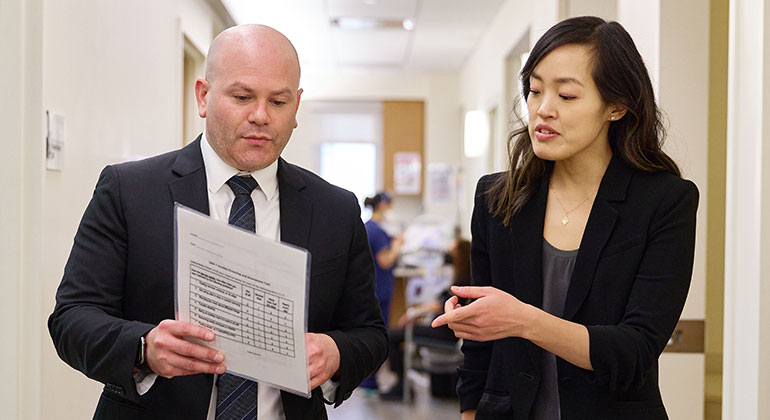Treatments

Once you have been diagnosed with esophageal cancer, we need to determine if—and how far—the cancer has spread. This is called staging the cancer.
We use several tests to stage esophageal cancer:
- Computed tomography scan: Shows the chest and upper gastrointestinal tract
- Positron emission tomography scan: Lets us see the size and location of the tumor
- Endoscopic ultrasound: Uses a narrow tube with a small ultrasound at its tip to see how thick the tumor is. We can also tell if your cancer has spread to esophagus walls or lymph nodes
- Bronchoscopy: Lets us see if the cancer has entered the windpipe or airways
- Interventional radiology or surgical biopsies: Shows areas outside of the esophagus.
There are five stages of esophageal cancer:
- Stage 0: Cancer cells only in the lining of the esophagus
- Stage 1: Cancer on the inside layers of the esophagus
- Stage 2: Cancer in the outer layers of the esophagus and possibly in the lymph nodes as well
- Stage 3: Cancer has spread beyond the esophagus and is in nearby tissue; it may also be in lymph nodes
- Stage 4: Cancer has spread to another part of the body
We develop a treatment plan for you based on the stage and location of your cancer, your age, and your overall health. We may use chemotherapy, radiation therapy, and surgery. We work with medical and radiation oncologists to develop this plan. We often arrange for chemotherapy and radiation treatments near your home.
Surgery
Mount Sinai offers the latest robotic and minimally invasive surgical techniques for esophageal cancer. Raja M. Flores, MD, Director of the Esophageal Cancer Center, is a recognized leader in thoracic surgery. Under his leadership, the team has developed an innovative approach for esophagectomy, which is less invasive, helps patients recover faster, and avoids complications. Your care team will determine the best approach for your cancer and overall health. The options we use most often are:
- Esophagectomy: Involves removing your esophagus and replacing it with stomach tissue. A successful procedure removes the malignant tissue and lets you eat normally. If your cancer is in the lower part of the esophagus, we may need to remove part of the stomach. If it is in the upper part of the esophagus, we may remove most of the esophagus and connect your stomach up closer to your neck. Dr. Flores has refined this procedure to cause less trauma to the internal organs, improve blood flow to the surgical site, and improve overall healing. Studies conducted on Dr. Flores’ innovative technique show fewer complications and more favorable outcomes.
- Minimally invasive esophagectomy: Uses small incisions and specially designed instruments and cameras. Mount Sinai is one of the few places that performs this procedure. We use laparoscopy and video-assisted thoracoscopic surgery (VATS) to remove the esophagus and replace it with stomach tissue. Minimally invasive procedures mean a shorter hospital stay and fewer complications.
- Lymph node removal: With either type of esophagectomy, we may remove one or more lymph nodes. Then we test them to see if they contain cancer cells. This information lets us know if you need additional treatment
- Palliative care procedures: We may perform procedures to prevent or relieve problems caused by your cancer. For example, we can place a feeding tube directly into your stomach or small intestine.
Chemotherapy
We use chemotherapy treatments to get rid of cancer cells, prevent recurrence, or relieve symptoms. This is a medical approach, using one or more drugs. Typically, we administer chemotherapy through infusion or pills. We can provide chemotherapy:
- After surgery: Called adjuvant, this approach kills any remaining cancer cells that may be left.
- Before surgery: Called neoadjuvant, the goal of this approach is to shrink the tumor and make surgery easier.
- For advanced cancers: With the goal of shrinking tumors and relieving symptoms. This approach may not cure the cancer, but it can help you live longer.
We give you chemotherapy multiple times over weeks or months.
Radiation Therapy
This approach uses high doses of radiation to kill cancer cells and shrink tumors. We can use radiation treatment before, during, or after surgery, similar to chemotherapy. There are several types of radiation therapy:
- External beam treatment: The most common approach for esophageal cancer, the radiation beams come from a machine outside your body. We aim the rays directly at your cancer, much as with X-ray. However, the beams are much stronger and the reaction more intense. We usually do radiation therapy multiple times, over several days or weeks.
- Brachytherapy: We insert radioactive material inside your body, very close to the tumor. High-dose brachytherapy involves several treatments for a few minutes at a time. With low-dose brachytherapy, we insert a lower dose of radiation for longer periods. It may remain in your body for a day or two. You may need to stay in the hospital for the low-dose approach.
Palliation of Esophageal Cancer
Even with treatment, you may find it difficult to swallow. We can perform minimally invasive endoscopic therapies to help. These techniques include endoscopic laser treatment (photodynamic therapy) and endoscopic stent placement. Many patients find these approaches decrease their pain.